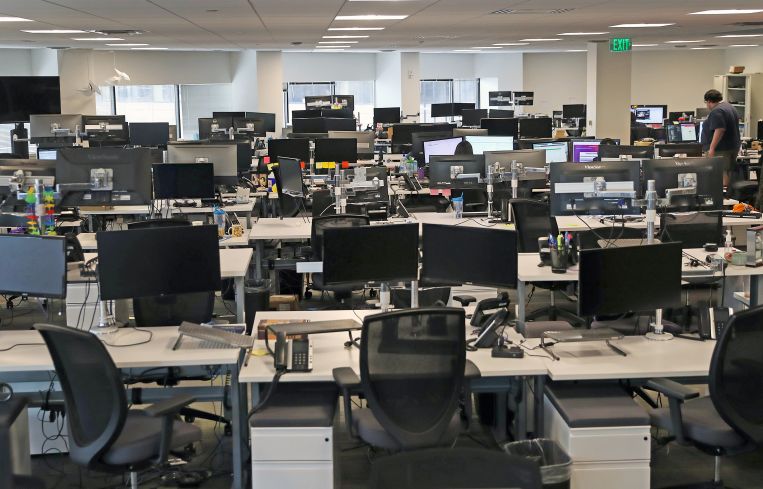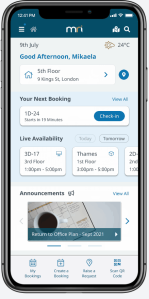How Seat-Tracking Proptech Aids Office Owners and Tenants
It’s more than just health and safety in the age of COVID
By Philip Russo September 28, 2021 9:00 am
reprints
Seat tracking in the workplace is sometimes perceived as a “Big Brother”-type function in which employers constantly surveil individual employees to determine where, how much, and how efficiently each of them is working.
In fact, according to some of the proptech software companies that help occupiers peer deeper into workers’ office and other space use, the technology is not so much focused on identifying who the individual is in a seat at any given moment, but rather the longer-term patterns of how employees use space. The resulting data from such insights can lead to major cost savings for occupiers and improved health and safety standards for all — especially given the uncertainty on all sides due to the pandemic.
After product production costs and paying employees, “the third cost, generally speaking, is the real estate that people occupy and that by no means is an insignificant amount,” said Andy Birch, vice president of portfolio marketing for Cleveland-headquartered MRI Software. “Many organizations have looked at that area and understand that space-planning, scheduling, and space utilization or optimization as being critical to the business.”
“The basic use case of our workplace analytics platform is not necessarily to know where people are on the floor, but to be able to reduce space if possible,” said Sabine Ehm, thought leadership and research manager at Locatee, a Swiss-based proptech office software company that operates in Europe and also has an office in New York City. “Even pre-pandemic, it’s been known in the industry that because of holidays, sickness, customer meetings and these kinds of things, at any given point in time, 20 percent of desks are not used.”
Locatee’s anonymized technology measures office occupancy by reading out network connections, Ehm said. “If someone’s in your office, using their Notebook and connecting either through ethernet or Wi-Fi to the company network, we can read that out and, by the numbers of network connections, we make out how many people are in an office.
“And by the ethernet connection, we can locate them on the floor. Through Wi-Fi, it’s a little bit more complicated a process of reading out the router signals, but also with Wi-Fi, we can make a triangulation of where people are on the floor as well.”
Locatee’s clients are “rethinking the purpose of the office, whether employees still need to come to an office or not,” Ehm said. “They’re having a bigger interest in understanding why people are coming and what types of work settings they are using.
“So that’s where it becomes more interesting for companies to understand mobility of people on the floor, and what kind of settings they prefer, so they can do their workspace program accordingly and provide more attractive work environments.”
Although Locatee’s software is primarily designed to help occupiers predict space use over time for greater leasing efficiency, it does have a live-data application for employees who might need to know where meeting space is available at a given time, Ehm said.
“During the lockdown, certain companies had issued thresholds for office occupancy and they would monitor very closely that those thresholds weren’t surpassed,” she said. “But I’d say in normal circumstances, the live data is not that relevant, at least not to the heads of corporate real estate or strategic positions in the company.”
Turntide Technologies is a sustainability company that provides in-building and remote-work tracking, primarily in tech-deficient spaces, such as warehouses, grocery and big-box retail locations, K-12 schools, quick-service restaurants, banks, auto showrooms, and small retail stores.
Sunnyvale, Calif.-based Turntide’s original purpose was to create smarter, more energy-efficient motors of all kinds, which it still does. In March, it acquired Riptide, a buildings automation company whose IoT (Internet of Things) platform supports smart, cloud-managed buildings. Riptide’s technology has become an integral part of Turntide’s “sustainable operations solution,” said Mimi Spier, vice president of marketing and growth strategy at Turntide.
“We are going into buildings and not only retrofitting their motor systems to be smart, intelligent motors, but we are applying a whole smart operations solution to the building,” Spier said. “With those smart operations come sensors and automation, and connectivity down at the building level, that then collects data and provides it up to the cloud, and to a full dashboard of insights, tracking and controls.”
Using the Riptide platform, Turntide can monitor where workers are at any given time and adjust temperature, lighting and indoor air quality.
“Tracking people is one way we look at each building and that experience is part of how you want to solve pain points,” Spier said. “Whether it be temperature controls, or knowing how many people are in your [building] for fire safety, there is a need to have more intelligence at all times.
“So tracking people is just one way of providing the best customer experience, the highest level of safety and health, and an optimal kind of experience overall for that customer or employee.”
Despite most software being designed to track workers in an anonymized fashion, in the age of COVID, the identification of employees and visitors in the workplace has become more complicated.

One function of MRI’s cloud-based software is that it allows clients to screen employees and visitors for COVID compliance with an iPad in the lobby or with a touchless QR code on a phone. Both allow employees and visitors to fill out the required health information and identification for contact tracing, Birch said.
“If there is an outbreak, you need to contact these people to inform them that they may have been exposed to COVID,” he said. “So it’s in their interest to say, ‘Yes, it’s okay for you to save this information.”
MRI uses seat-tracking technology from two proptech workplace startups it acquired earlier this year, New Zealand-based WhosOnLocation, a people presence management solution, and Sunnyvale-based Manhattan, which Birch calls “workplace central” for managing space planning and spatial space utilization.
Along with other workplace companies MRI has acquired, the 50-year-old firm (“We like to think of ourselves as the founders of the proptech industry,” Birch said.) has put together a software platform to deal with the complexity of corporate tenant workplace management.
“Interestingly, not only do we provide it to clients, but we also use the solutions internally,” Birch said. “So, depending on which phrase you prefer, we eat our own dog food, or drink our own champagne. I think I prefer the latter, but you can choose.”
Philip Russo can be reached at prusso@commercialobserver.com.


